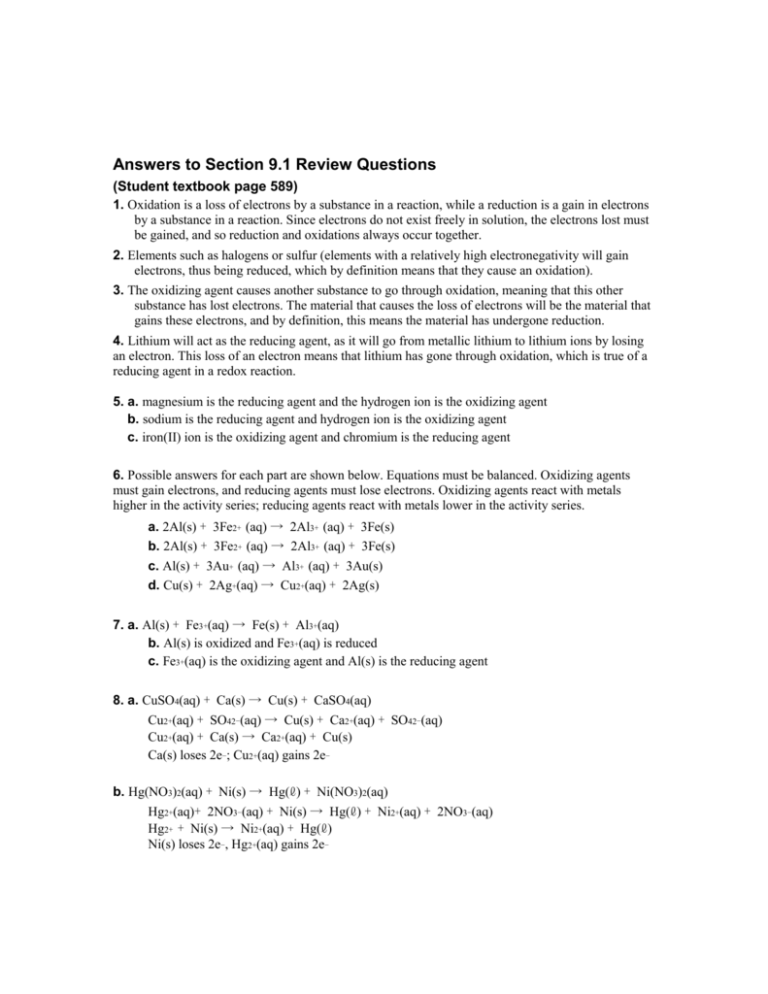Answers to Section9.1page589
advertisement

Answers to Section 9.1 Review Questions (Student textbook page 589) 1. Oxidation is a loss of electrons by a substance in a reaction, while a reduction is a gain in electrons by a substance in a reaction. Since electrons do not exist freely in solution, the electrons lost must be gained, and so reduction and oxidations always occur together. 2. Elements such as halogens or sulfur (elements with a relatively high electronegativity will gain electrons, thus being reduced, which by definition means that they cause an oxidation). 3. The oxidizing agent causes another substance to go through oxidation, meaning that this other substance has lost electrons. The material that causes the loss of electrons will be the material that gains these electrons, and by definition, this means the material has undergone reduction. 4. Lithium will act as the reducing agent, as it will go from metallic lithium to lithium ions by losing an electron. This loss of an electron means that lithium has gone through oxidation, which is true of a reducing agent in a redox reaction. 5. a. magnesium is the reducing agent and the hydrogen ion is the oxidizing agent b. sodium is the reducing agent and hydrogen ion is the oxidizing agent c. iron(II) ion is the oxidizing agent and chromium is the reducing agent 6. Possible answers for each part are shown below. Equations must be balanced. Oxidizing agents must gain electrons, and reducing agents must lose electrons. Oxidizing agents react with metals higher in the activity series; reducing agents react with metals lower in the activity series. a. 2Al(s) + 3Fe2+ (aq) → 2Al3+ (aq) + 3Fe(s) b. 2Al(s) + 3Fe2+ (aq) → 2Al3+ (aq) + 3Fe(s) c. Al(s) + 3Au+ (aq) → Al3+ (aq) + 3Au(s) d. Cu(s) + 2Ag+(aq) → Cu2+(aq) + 2Ag(s) 7. a. Al(s) + Fe3+(aq) → Fe(s) + Al3+(aq) b. Al(s) is oxidized and Fe3+(aq) is reduced c. Fe3+(aq) is the oxidizing agent and Al(s) is the reducing agent 8. a. CuSO4(aq) + Ca(s) → Cu(s) + CaSO4(aq) Cu2+(aq) + SO42-(aq) → Cu(s) + Ca2+(aq) + SO42-(aq) Cu2+(aq) + Ca(s) → Ca2+(aq) + Cu(s) Ca(s) loses 2e-; Cu2+(aq) gains 2eb. Hg(NO3)2(aq) + Ni(s) → Hg(ℓ) + Ni(NO3)2(aq) Hg2+(aq)+ 2NO3-(aq) + Ni(s) → Hg(ℓ) + Ni2+(aq) + 2NO3-(aq) Hg2+ + Ni(s) → Ni2+(aq) + Hg(ℓ) Ni(s) loses 2e-, Hg2+(aq) gains 2e- c. Note that AgCl and TlCl are compounds of low solubility and this reaction will occur only to a limited extent. AgCl(aq) + Tl(s) → Ag(s) + TlCl(aq) Ag+(aq) + Cl-(aq) Tl(s) → Ag(s) + Tl+(aq) + Cl-(aq) Ag+(aq) + Tl(s) → Tl+(aq) + Ag(s) Tl(s) loses 1e-, Ag+(aq) gains 1e9. Elements such as iron, zinc or magnesium (any element that is a stronger reducing agent than cobalt) can be used to cause a spontaneous reaction. Fe(s) + Co2+(aq) → Co(s) + Fe2+(aq) Zn(s) + Co2+(aq) → Co(s) + Zn2+(aq) Mg(s) + Co2+(aq) → Co(s) + Mg2+(aq) 10. Combustion of a hydrocarbon e.g. CH4(g) + 2O2(g) → CO2(g) + 2H2O(g) Carbon changes from an oxidation number of -4 in CH4(g) to +4 in CO2(g). This loss of electrons is an oxidation. Oxygen changes from an oxidation number of 0 in O2(g) to -2 in H2O(g). This gain of electrons is a reduction. 11. It is not possible because you cannot have two oxidation reactions and no reduction reaction. 12. These photos indicate that a redox reaction had spontaneously occurred, to show that the metal is a stronger reducing agent than silver.




